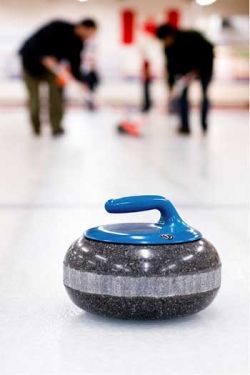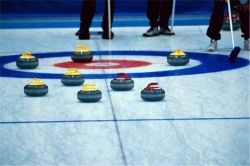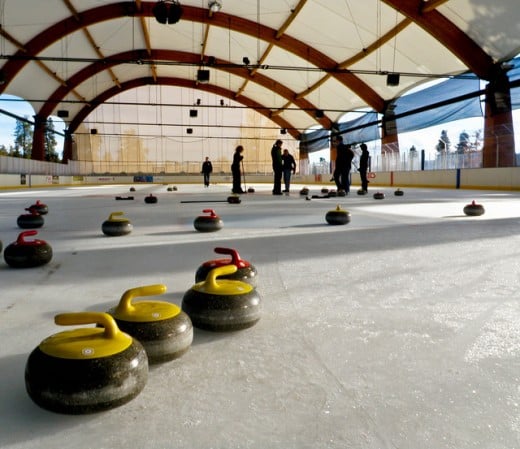How to Understand the Winter Sport of Curling

Curling is a Game of Skill and Strategy -- It's Like Crokinole on Ice
Do you want to learn about the winter sport of curling? This page defines the terminology used in curling and explains the basic rules and strategies of the game. At the bottom of the page, a humorous video shows how its done.
Curious about curling? I'm not a curler myself, but I grew up in the Canadian Province of Manitoba. This is the heart of curling country, and my dad was an avid curler. In fact, he was a Skip -- which I will explain later if you don't know the term. I spent many hours during my youth sitting in curling rinks watching my dad and his teammates play for recreation and in competitions.
Curling originated in Scotland. The joke has it that a Scotsman dropped a haggis on a frozen pond. As the haggis slid away, the Scotsman chased it with a broom. Thus, curling was invented, or so the joke goes.
This page introduces the terminology and language used in curling. It explains the basics of how the game is played, and the strategy involved, as well as the sportsmanship expected of players and spectators. You will also find links to major curling web sites, photos of curling, and an amusing video showing a man attempting to learn curling and discovering its less easy than he thought.
If you ever played the board game known as crokinole, you will have a basic understanding of how the game is played.
How to Talk to a Curler
If you want to talk to a curler, you'll need to understand the language. Here are the terms you'll hear curlers discussing.

Curling Terminology
- Rink: A rink is the building or venue in which curling occurs. You go to a Curling Rink. In some locations, rink also refers to a curling TEAM. There are four members in a rink (team). A curling rink goes to a curling rink to curl. Got it?
- Rock: A rock is a flat bottomed object with a handle. It weighs about forty pounds. A curler semi throws, semi pushes a curling rock so it slides down a sheet of ice with the hope of making points. This item is called a Stone outside of North America.
- Broom: Curlers use a broom to sweep the ice vigorously in front of the sliding rock. This sweeping helps guide the rock. A broom is sometimes called a curling brush.
- Skip: The captain of a curling rink is called the Skip. The Skip is allegedly the best curler in the rink. He or she determines the strategy and indicates to the other players where to aim the rock.
- Lead: The most inexperienced or least skilled curler is called the Lead. The Lead plays first.
- Second: The Second is the player who plays after the lead has played.
- Third: The Third plays after the Second plays. When the Skip is playing, the Third indicates to the Skip where the rock should be aimed.
- End: An end would be called an inning if it were baseball. Recreational curling usually has eight ends. Competitive curing is likely to have ten ends.
- House: The concentric circles painted on each end of the ice rink are called the House.
- Tee Line: The Tee Line is the line that indicates the entrance or beginning of the House.
- Hog Line: The Hog Line is the line drawn across the ice a short distance in front of the place where the curler squats to play his or her rock. The player must release the curling rock before it touches the hog line, or the rock is removed from play. Similarly, the rock must cross the hog line at the other end, or it is removed from play.
- Burning the Rock: If a member touches the rock with broom, foot or any body part, it is called burning the rock. A player is honour bound to notify the Skip if he or she has burned the rock.
- Bonspiel: A curling competition is called a Bonspiel.
Important Curling Links on the Web
- World Curling Federation
This is the official website of the World Curling Federation - Canadian Curling Association
On an annual basis, the Canadian Curling Association sanctions and conducts 8 national curling championship events. - The Curling School
Welcome to the Curling School. Here you can learn more about curling, and learn about the latest in curling technique and equipment. - Wheelchair Curling
Wheelchair Curling's home on the Internet - TSN Curling News
TSN Curling news and results; get the latest curling highlights and score updates; access curling tournament standings, updates and curling videos; team schedules, Brier and headlines.
How a Curling Game is Played
The Strategy of Curling -- It's like Crokinole
When playing a curling game, each player throws two rocks, to a total of 16 rocks per End. The Leads play first, taking turns. The Seconds play next, then the Thirds and finally the Skips.
The goal is to finish the End with more of your team's rocks closer to the center of the House than your opponent's rocks. It's much like the board game of Crokinole.
The strategy is to get one or more of your team's rocks near the center of the House, then place other rocks around this rock as a defense. Doing this entails trying to knock out your opponent's rocks while protecting your own. This sounds easy but requires considerable skill to accomplish. Rocks thrown too hard may knock out your own rocks instead of the opponent's. Rocks thrown too lightly may not cross the hogline and be disqualified. Rocks may hit an opponent's rock and drive it closer to the center of the House rather than knocking it further away. Rocks must often be thrown with a slight "curl" so they go where you want them to go.
The Skip indicates where he wants the player to aim, usually by placing his or her broom in the desired location.
Once the rock is played, members of the same team may sweep in front of the rock with a broom. This sweeping clears the ice and helps guide the rock to the desired location. Once the rock enters the House, members of the opposing team may sweep it in an attempt to change the direction or lure the rock out of play.
When attending the curling game, the noisiest part of the game will be the Skip shouting, "Sweep, sweep!".
The End is finished when all 16 rocks have been played. The scoring involves determining which team has a rock closest to the center. That team scores one point for each rock that is closer to the center than an opponent's rock. In the event of a tie, the teams continue playing until one side scores.

Sportsmanship of Curling
Curling is a game of good sportsmanship. Abide by the following guidelines and you will not disgrace yourself at a recreational game or Bonspiel.
- It is bad manners to cheer and celebrate when the opposing team makes an error. This is not hockey.
- Players are honour - bound to report their own fouls, such as burning the rock while sweeping.
- Losing teams are expected to concede defeat when it becomes apparent that they have no reasonable chance of winning.
- It is customary for the winners to buy the losers a drink after playing.






